Integrative Case Study J2 due December 02
dorset coast gcse case study -回复

dorset coast gcse case study -回复The Dorset Coast is a popular case study for GCSE geography students due to its diverse range of coastal features and processes. In this article, we will explore the key aspects of the Dorset coast, step by step.1. Introduction to the Dorset Coast:Located in the southwest of England, the Dorset coast stretches for about 140 kilometers, from Lyme Regis in the west to Christchurch in the east. It is renowned for its stunning beauty, rich geological history, and unique coastal formations. The area is a designated UNESCO World Heritage Site, known as the Jurassic Coast, due to the wealth of fossils and rock formations that span over 185 million years of history.2. Geological History and Formation:The geological history of the Dorset coast spans from the Triassic period to the Cretaceous period. The region features distinctive rock formations such as Lyme Regis Blue Lias and the cliffs of white chalk known as the Purbeck Beds. Through a combination of erosion and sedimentation, these geological features have been carved into dramatic cliffs, coves, bays, and headlands over millionsof years.3. Coastal Features:The Dorset coast boasts a wide variety of coastal features. Chesil Beach, a tombolo that stretches for 18 miles, is a famous example of a depositional landform in the area. It connects the Isle of Portland to the mainland and protects the Fleet Lagoon. Moreover, the famous Durdle Door is a natural limestone arch that formed through the erosion of the surrounding Purbeck Beds. The Old Harry Rocks, a series of chalk stacks located near Studland Bay, are another iconic feature that resulted from coastal erosion processes.4. Erosion Processes:Several erosion processes shape the Dorset coast. Hydraulic action occurs when waves crash against cliffs, exerting pressure and forcing out rock fragments. Abrasion is the grinding action of sediment carried by waves against the coastline, wearing it away over time. Attrition causes rocks and boulders to become smaller and rounded as they collide with each other. Solution occurs when certain rocks, such as chalk, are dissolved by acidic seawater. These processes work together to shape and erode the coastline.5. Management Strategies:Coastal management is a crucial aspect of protecting the Dorset coast from erosion and other risks. In areas where erosion is a concern, strategies such as beach nourishment and the construction of sea walls or groynes have been implemented. Beach nourishment involves adding sand or shingle to the beach to increase its width and resilience. Sea walls and groynes are built to absorb wave energy and prevent further erosion. Nevertheless, there are ongoing debates about the effectiveness and environmental impacts of these measures.6. Tourism and Economic Importance:The Dorset coast is a popular tourist destination, attracting millions of visitors each year. Tourism plays a significant role in the local economy, supporting businesses such as hotels, restaurants, and outdoor activity providers. The stunning landscapes, rich wildlife, and cultural heritage of the Dorset coast provide a unique experience for visitors, contributing to sustainable economic development in the region.In conclusion, the Dorset coast offers an excellent case study for GCSE geography students to understand coastal processes andlandforms. From its geological history to its diverse range of coastal features, this area provides valuable insights into erosion processes and coastal management strategies. With its natural beauty and economic importance, the Dorset coast stands as a captivating example of the complex interactions between humans and the environment.。
家庭教育外文文献
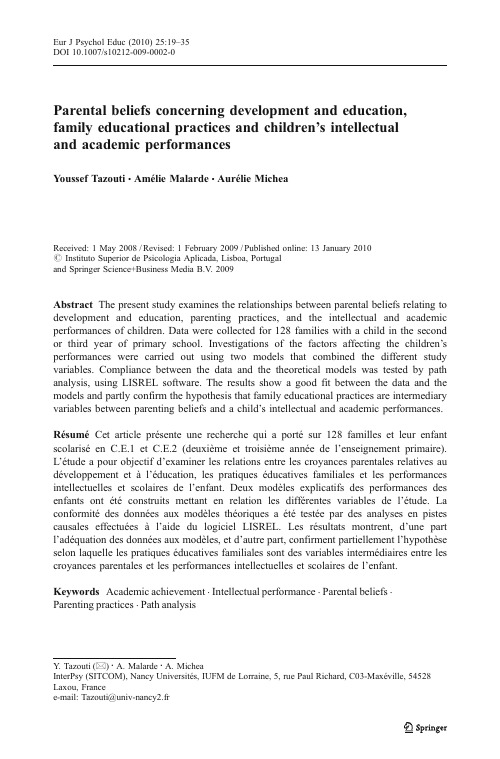
Parental beliefs concerning development and education,family educational practices and children ’s intellectualand academic performancesYoussef Tazouti &Amélie Malarde &Aurélie MicheaReceived:1May 2008/Revised:1February 2009/Published online:13January 2010#Instituto Superior de Psicologia Aplicada,Lisboa,Portugal and Springer Science+Business Media B.V .2009Abstract The present study examines the relationships between parental beliefs relating to development and education,parenting practices,and the intellectual and academic performances of children.Data were collected for 128families with a child in the second or third year of primary school.Investigations of the factors affecting the children ’s performances were carried out using two models that combined the different study pliance between the data and the theoretical models was tested by path analysis,using LISREL software.The results show a good fit between the data and the models and partly confirm the hypothesis that family educational practices are intermediary variables between parenting beliefs and a child ’s intellectual and academic performances.RésuméCet article présente une recherche qui a portésur 128familles et leur enfant scolariséen C.E.1et C.E.2(deuxième et troisième année de l ’enseignement primaire).L ’étude a pour objectif d ’examiner les relations entre les croyances parentales relatives au développement et àl ’éducation,les pratiques éducatives familiales et les performances intellectuelles et scolaires de l ’enfant.Deux modèles explicatifs des performances des enfants ont étéconstruits mettant en relation les différentes variables de l ’é conformitédes données aux modèles théoriques a ététestée par des analyses en pistes causales effectuées àl ’aide du logiciel LISREL.Les résultats montrent,d ’une part l ’adéquation des données aux modèles,et d ’autre part,confirment partiellement l ’hypothèse selon laquelle les pratiques éducatives familiales sont des variables intermédiaires entre les croyances parentales et les performances intellectuelles et scolaires de l ’enfant.Keywords Academic achievement .Intellectual performance .Parental beliefs .Parenting practices .Path analysisEur J Psychol Educ (2010)25:19–35DOI 10.1007/s10212-009-0002-0Y .Tazouti (*):A.Malarde :A.MicheaInterPsy (SITCOM),Nancy Universités,IUFM de Lorraine,5,rue Paul Richard,C03-Maxéville,54528Laxou,Francee-mail:Tazouti@univ-nancy2.fr20Y.Tazouti et al. IntroductionA review of the psychology literature shows that research into parental beliefs concerning children’s development and education is a relatively recent phenomenon(Goodnow1988; McGillicuddy-DeLisi1982;Miller1986;Pajares1992;Thompson1992).In their review of the literature in this field,Hirsjärvi and Perälä-Littunen(2001)highlight the fact that many authors have used the expression parental beliefs without precisely defining what they mean by it and without differentiating the concept of parental beliefs from other similar terms.In fact,researchers have used numerous synonyms for beliefs,including knowledge, ideas,schemes,opinions,thoughts,representations,attitudes,perspectives,expectations, judgments,perceptions,conceptions,images,implicit theories,naïve theories,and social cognition.For example,Goodnow(1988)used the term ideas to denote“…judgments about the nature of the raw material,attributions of causality,knowledgeability about development,opinions,conditions that influence development,judgments about ways to assess a child’s progress,and estimates of children’s competence at various ages”(p.288). In the French-speaking world,a large number of studies have employed the concept of social representation in the field of education(Mugny and Carugati1985;Chombart de Lauwe and Feuerhahn1994;Emiliani and Molinari1994;Montandon1997;Constans and De Léonardis2003).As Bergonnier-Dupuy(2005)noted,the expression implicit theories of development and education is also widely used.Vandenplas-Holper(1987)defines this concept as“knowledge relating to children’s needs,to the development process and to the educational actions of parents,teachers or educators,who,without being professionally trained psychologists or psychiatrists,undertake the education of children within the family or within institutions such as crèches and schools”(p.18).Given this wide range of terminology,one of our first tasks was to decide which of the existing terms to use.We feel that the term belief is preferable to the other commonly used expressions,especially knowledge.According to Moscovici(1998),knowledge and belief must be considered two very different modes of representation that involve distinct forms of cognition,both in the way they are elaborated and in the way they function.Other researchers consider beliefs to be more solid than knowledge and that changes in beliefs have profound causes and effects(Marcello1986).The term knowledge evokes the idea of accuracy and precision,whereas beliefs are not necessarily precise.In psychology,when we evoke the question of beliefs,we are immediately confronted by the opposition between “rational and irrational”(Apostolidis et al.2002).We also had to define the notion of parental beliefs and to draw up a distinction between parental beliefs relating to development and those relating to education.These definitions would allow us to distinguish parental beliefs from other closely related concepts,such as parental values and objectives for education and parental aspirations for their children. Thus,we define parental beliefs relating to development as the representations parents have concerning their child’s general development.These beliefs concern various aspects of development,such as its chronology,parental accuracy,determinants of development,and the role parents feel they play in their child’s development.Beliefs relating to education are the beliefs parents have about the way their children,or children in general,are educated. These beliefs concern the parent’s educational principles(rules of daily life,accountability of children,consideration of the child’s needs,etc.),as well as the role parents feel they play in their children’s education.Miller(1986)describes four of the questions that have guided many researchers:(1) what is the nature of parental beliefs?(2)how are parental beliefs formed and modified?(3) what is the relationship between parental beliefs and parents’behaviors towards theirParental beliefs on children’s development and education21 children?(4)What is the link between parental beliefs and their children’s intellectual development?In the following sections,we use Miller’s questions as a framework for examining recent work and for building the two theoretical models we tested empirically.What is the nature of parental beliefs?Parental accuracyResearch into parental accuracy has involved asking parents to estimate how successfully their child will carry out a given task and then asking the child to carry out that task. Parental accuracy is the difference between the parent’s prediction and the child’s performance.Studies of this variable have been conducted from either a Piagetian perspective(Hunt and Paraskevopoulos1980;Miller1986)or from a Vygotskyian view of development(Miller1986).According to Piaget(1975),human intelligence is a particular case of biological adaptation through a process involving the assimilation by the psyche of new experiences.A child cannot accommodate or assimilate all new developmental experiences because these experiences must be suited to the child’s level of development.In this orthogenetic vision,parents or educators can only further a child’s intellectual development if their awareness of the child’s abilities is sufficient for them to be able to offer the right experiences at the right time(Adams and Crane1980;Hunt and Paraskevopoulos1980;Miller1986;Miller and Davis1992;Serbin et al.1983).According to the Vygotskyian view,development is essentially epigenetic,and parents and educators influence the proximal zone of development.This allows parents to anticipate and accelerate the child’s development.In other words,parents can offer their children development opportunities.Parental accuracy has been evaluated in several fields of academic achievement,such as reading(Baker and Scher2002;Campbell et al.1991;Wagner and Spratt1988)and mathematics(Aunola et al.2003;Campbell et al.1991;Parsons Eccles et al.1982),and in the field of intellectual performance(Hunt and Paraskevopoulos1980;Miller1986).The results of these studies,which have mostly involved mothers,show that parents tend to overestimate their offspring(Miller1986;Hunt and Paraskevopoulos1980).Miller(1986) found that this overestimation is moderate and that it is positively correlated with the child’s cognitive development.In fact,children of mothers who overestimate their offspring’s development perform better on IQ and Piagetian tests than children of mothers who underestimate their offspring’s capabilities.Research into parent’s beliefs about their children and about children in general indicates that most mothers tend to overestimate their own children’s abilities and underestimate the abilities of other children(Lescarret and Bertrand2002).The determinants of developmentStudies show that some parents believe the most important determinant of development to be genetics,whereas other parents believe that the most important determinant is the environment.Similarly,some parents believe they should play an active role in their children’s development,whereas others feel their role should be more passive(Becker and Hall1989;Knight and Goodnow1988;Machida and Holloway1991;Russell and Russell 1982).Research into representations of child development(Emiliani and Molinari1994; Molinari and Emiliani1996)indicates that mothers’representations are regulated by22Y.Tazouti et al. identity dynamics(e.g.,mothers of families vs.working women)and by the different degrees of responsibility and involvement that these mothers feel with respect to children in general and to their children in particular.Palacios(1990)identified three types of parent: (1)Traditional parents have an innatist view of development and thus believe that they cannot influence their child’s development.(2)Modern parents take an environmentalist view of cognitive development and thus believe they can influence their child’s development.(3)Paradoxical parents have beliefs that are sometimes closer to those of traditional parents and sometimes closer to those of modern parents.In addition,Sigel (1985)showed that parents who take a constructivist view of child development more readily adopt distancing strategies when interacting with their children and that the children of such parents have higher cognitive abilities than other children.In other words,these parents implement educational practices that encourage autonomy and accountability in their children,which promotes the child’s cognitive development.Parental beliefs with respect to educationParental beliefs relating to education have been studied by a number of workers(e.g., Emiliani and Molinari1988;Newberger1980;Palacios1990;Pourtois1979).In her1980 study,Newberger described four hierarchical levels of“parental reasoning”about the objectives bestowed on education.The first level(egoistic orientation)includes parents who see their child as a projection of themselves and who organize their parental role according to their own needs and desires.The second level(conventional orientation) corresponds to a normative approach to education,as it describes parents who define their roles in terms of notions that are socially correct or incorrect.At the third level(subjective-individualistic orientation),the parent’s role is oriented by the needs of the child and the means available to respond to those needs.Parents on the fourth level(process or interactional orientation)focus on parent–child interactions and the fact that the parent’s role evolves as a result of interactions with the child.This fourth level seems to be the most suitable for stimulating intellectual development.Pourtois(1979)collected a wide range of quantitative and qualitative data on children, their level of development,and their school adaptation,in order to examine how mothers teach their5-to6-year-old children.One of the most interesting findings of this study was the relationship between maternal attitudes to education and maternal educational behaviors.How do parental beliefs form,and how are they modified?A number of authors,most notably Nespor(1987),believe that belief systems are less malleable and less dynamic than knowledge systems.Beliefs are thought to be characterized by their stability and by the fact that profound transformations are needed to change them.However,not all workers in the field share this point of view.For example, Molinari and Emiliani(1999)believe that the anchoring processes for representations are the result of a dynamic governed by forces such as belief systems,social belonging,and perception and attribution of responsibility.Sigel(1985)shares the view that beliefs are not fixed and that they are continually being reorganized as a function of new information assimilated through parenting and professional experiences,the media,consultations with experts,and informal social intercourse.Nevertheless,studies show that the beliefs held by adolescent mothers may be similar to the beliefs of older mothers if certain variables areParental beliefs on children’s development and education23 controlled(Stoiber and Houghton1993).In fact,the age of the mother does not appear to be the only factor explaining the origin of beliefs(Reis1989).Other important factors include the socioeconomic status of the family,the presence or absence of the father,and the support available to the mother(mother,friend,etc.).The characteristics of the child also affect parents’beliefs in their ability to influence their children’s development.Mothers of gifted children attribute their offspring’s success to family educational practices (Himelstein et al.1991),whereas mothers of children who develop more slowly underestimate their impact on their child’s development(Serbin et al.1983).This result indicates that the relationship between parental beliefs and a child’s intellectual development is bidirectional.What are the links between parents’beliefs,parental educational practices,and a child’s intellectual and academic performances?Many workers support the idea that parents’beliefs relating to development and education guide parental educational practices,which,in turn,influence the child’s intellectual and academic performances(e.g.,Goodnow1988;Goodnow and Collins1990;Sigel1985). The research presented above indicates that parental beliefs influence family educational practices(e.g.,Hunt and Paraskevopoulos1980;Miller1986;Miller and Davis1992).For example,parents who take an environmentalist view of cognitive development and who feel that they can influence their child’s development would be expected to adopt educational practices in line with their beliefs.These parents would,therefore,offer their children more stimulation and provide an environment that promotes cognitive development.However,very few empirical studies have been conducted to test this hypothesis(Hunt and Paraskevopoulos1980;Miller1986).Consequently,the present study was set up to provide such an empirical test.It can be assumed that the parents’representations of development and education will influence the educational practices they adopt with their child.Hence,educational practices are intermediary variables between parental beliefs and the child’s intellectual development.We used current theoretical knowledge to draw up two models that would allow us to investigate a child’s intellectual ability and academic achievements.We also took into account a number of models that have been validated in the literature(Pourtois1979; Pourtois and Desmet1989;Tazouti2003).These models describe the networks of relationships between the variables most frequently considered by workers in this field. Presentation of the theoretical models to be testedThe first model(Fig.1)describes the hypothesis that parental beliefs relating to development and family educational practices are intermediary variables between the social level of the family and the characteristics of the child.The social level of the family is the independent variable,and the child’s academic(ACADPER)and intellectual performances are the final dependent variables.Three variables concerning parental beliefs relating to development were considered:(1)Parental beliefs relating to“genetic influence”,(2)Parental beliefs relating to “environmental influence”,and(3)Parental beliefs relating to effective development.The model also included two dimensions of family educational practices:parental responsiveness (RESPON)and parental demandingness.24Y.Tazouti et al.LegendSL:Social level of the familyGENBEL:Parental beliefs relating to the influence of genetics on developmentENVBEL:Parental beliefs relating to the influence of the environment on developmentAFFBEL:Parental beliefs relating to affective developmentRESPON:Parental responsivenessDEMAND:Parental demandingnessACADPER:Academic performanceINTPER: Intellectual performanceExplanatory note: each rectangle represents a variable; a unidirectional arrow represents the causal effect of a variable on a dependent variable (effectmeasured by a pathway coefficient); a double arrow indicates a relationship between two variables for which we have not hypothesised a causal link. Fig.1Pathway model of parental beliefs relating to developmentA major advantage of pathway-based models is that they allow us to go beyond simple causal systems,in which an explanatory variable depends on another explanatory variable, to complex causal systems,in which several explanatory variables depend on other explanatory variables.In the model shown in Fig.1,each rectangle represents an observed variable.A unidirectional arrow shows the causal effect of an independent variable on a dependent variable;hence,all the unidirectional arrows indicate hypotheses.For example, we can postulate that higher parental responsiveness is linked to better academic performances by their children(RESPON→ACADPER).A double arrow indicates a relationship between two variables for which we have not hypothesized a causal link.This is the case for the relation between academic performance and the child’s intellectual level.The second model(Fig.2)shows the hypothesis that parental beliefs relating to education and family educational practices are intermediary variables between the social level of the family and the characteristics of the child.This model includes the same variables as the first model,except that the variables concerning development have been replaced by the variables concerning parental beliefs relating to education.Hence,the three new variables in the second model are parental educational beliefs concerning punishment, parental educational beliefs concerning rules,and parental educational beliefs concerning rewards.MethodParticipantsParticipants were128parents and their children attending the second or third year of primary school.The sample included72girls and56boys with a mean age of8years 7months.Parental beliefs on children’s development and education25LegendSL:Social level of the familyPUNBEL:Parental beliefs relating to punishmentRULBEL:Parental beliefs relating to rulesREWBEL:Parental beliefs relating to rewardsRESPON:Parental responsivenessDEMAND:Parental demandingnessACADPER:Academic performanceINTPER:Intellectual performanceFig.2Pathway model of parental beliefs relating to educationMeasuresMeasure of the families’social levelThe social level of the children’s families was measured by calculating an economic–cultural index combining three indicators:(1)the mother’s level of education;(2)the father’s level of education;(3)the size of the home,that is to say,the number of rooms in the home divided by the number of people living there.Our decision to combine these three indicators was justified by the relatively high correlations between them(correlations vary between0.37and0.61and are all significant at p<0.01).Our economic–cultural index showed a high degree of variability(mean=2.70,standard deviation=0.78).Questionnaires measuring parental beliefs concerning development and educationA questionnaire measuring parental beliefs relating to development was drawn up.It included 26items(see right-hand part of Table1for examples of the items)measuring three dimensions:(1)parental beliefs relating to a genetic concept of development,in which development is attributed to innate(dispositional)factors;(2)parental beliefs relating to an environmental concept of development,in which development is attributed to environmental (situational)factors;(3)parental beliefs relating to the effective development of the child.The parents were also asked to complete a questionnaire measuring their beliefs relating to education.This questionnaire had seven items measuring the parents’beliefs relating to three areas of education:“rules for daily life,”“punishment,”and“rewards.”Questionnaire measuring family educational practicesOur measures of family educational practices were inspired by Maccoby and Martin(1983), who distinguished two dimensions in family educational styles:parental demandingness and parental responsiveness.Thus,for the present study,we reused the questionnaire drawnup by Tazouti (2003),which has 29items (see Table 1for examples of the items)measuring the two dimensions described by Maccoby and Martin (1983).Parental demandingness is the first dimension.It covers the regularity of family life,parental control,and parental support.The second dimension,parental responsiveness,covers flexibility in family life and the encouragement parents give their children to be self-reliant.The internal consistency coefficients (Cronbach ’s alpha)were satisfactory for all the measures (Table 1),except for the scales measuring “parental educational beliefs relating to punishment ”and “parental educational beliefs relating to rewards,”which had quite low alpha coefficients (0.46and 0.42,respectively).Intellectual and academic performancesIn order to test the children ’s intellectual performances,we used a shortened version of “cahier 2”of the ECNI (collective scale of intellectual level),as finalized by Benedetto (1969).This test measures inductive and analogical reasoning abilities.Two of its advantages are:it can be administered collectively,and it strongly correlates with classic intelligence tests such as the WISC.We used a shortened version of the test,consisting of four subtests,two in the form of verbal scales (verbal analogies and membership of a category)and two in the form of nonverbal scales (matrices and series to complete).The internal consistency coefficient for the whole scale was satisfactory (0.85).For the Table 1Descriptive statistics,item analyses,and examples of items from the scale used to measure beliefs and family educational practicesScales Mean Standard deviation Number of items Cronbach ’s alpha Example of items (Responseon a 5-point Likert scale)Parental beliefs relating to developmentParental beliefs relating todevelopment “geneticconception ”1.950.65130.90The development of a child ’s intelligence depends mostly on genetic factors Parental beliefs relating todevelopment “environmentalconception ”3.890.4980.65To become intelligent,you have to learn a lot Parental beliefs relating toeffective development3.320.6950.50It is difficult to change the nature of a turbulent child Parental beliefs about educationParental educational beliefsrelating to punishment3.430.7630.46Punishment is the best way of educating children Parental educational beliefsrelating to rules3.500.9420.72Family life should be organized according to strict rules Parental educational beliefsrelating to rewards4.580.5220.42A child should be rewarded for good behavior Family educational practicesParental demandingness 3.540.43180.74Y our family has a regimentedlife (regular times,habits torespect,etc.)Parental responsiveness 3.120.55110.69You allow your child tomake decisions aboutthings that concern him/her(e.g.,choice of clothes)26Y .Tazouti et al.Parental beliefs on children’s development and education27 measures of academic performance,we asked the teachers to rate the children’s abilities in mathematics and in French,using a10-point scale(mean=6.83,standard deviation=2.08).ResultsCorrelational analysesTable2shows the correlations between the study variables.Five of the variables are significantly correlated(p<0.05)with the child’s intellectual performance.In descending Table2Matrix of correlations between the study variables12345678910 Social level of1the family0.42**1Child’s academicperformance0.24**0.63**1Child’sintellectualperformance−0.070.030.061Parental beliefsrelating todevelopment“geneticconception”−0.15−0.030.08−0.071Parental beliefsrelating todevelopment“environmentalconception”0.18*0.19*0.26**0.05−0.011Beliefs relatingto effectivedevelopment−0.07−0.03−0.07−0.050.23**0.041Parentaleducationalbeliefs relatingto punishment0.090.21*0.050.21*0.26**0.110.27**1Parentaleducationalbeliefs relatingto rules0.080.120.18*−0.050.45**0.02−0.110.061Parentaleducationalbeliefs relatingto rewards0.18*0.06−0.01−0.110.25**0.010.28**0.39**0.101 Parentaldemandingness0.22*0.30**0.21*−0.020.12−0.04−0.26**0.040.29**0.02 ParentalresponsivenessN=128**p<0.001;*p<0.001order,these variables are:academic performance(0.63),beliefs relating to effective development(0.26),economic–cultural index(0.24),parental responsiveness(0.21),and parental educational beliefs relating to rewards(0.18).Four variables are significantly correlated(p<.05)with the child’s academic performance.In descending order,these variables are:economic–cultural index(0.42),parental responsiveness(0.22),beliefs relating to effective development(0.18),and parental demandingnesss(0.18).Path analysisThe parameters of the theoretical models(Figs.1and2)and the goodness-of-fit indices were calculated using LISREL software version8.50(Jöreskog and Sörbom1998).Figure3gives the results of the path analysis for parental beliefs relating to development.The fit of the data to the model is satisfactory,as all the goodness-of-fit indices show values close to or below the values usually considered to indicate a satisfactory fit(χ2=12.76for10df;p=.24;RMSEA(residuals)=0.04;AGFI=0.91).In total,the model accounts for22%of the variance of academic performance and8.4%of the variance of intellectual performance.In the interests of clarity,only pathways that were significant at0.05are shown with solid lines in Fig.3.A number of observations can be made:1.A family’s social level does not significantly influence parental beliefs relating todevelopment,and this is the case for both genetic and environmental conceptions of development.The only significant link is between social level and parental beliefs relating to effective development(0.18).However,there is a significant link between social level and family educational practices:the higher the social level of the family, the greater the parents’demandingness and responsiveness towards their children(the pathway coefficients are0.22and0.26,respectively).The social level of the family significantly influences a child’s academic and intellectual performances(0.37and0.21,respectively).2.The links between parental beliefs relating to development and parental educationalpractices are not significant.The only exception is the positive and significant relationship between parental beliefs relating to an environmental conception of development and parental demandingness(0.28).Chi-square with 10 degrees of freedom = 12.76, p = 0.24, RMSEA = 0.05, AGFI = 0.91 2 = 8.4 % 2 = 22 %Fig.3Results of the pathway analysis for parental beliefs relating to development28Y.Tazouti et al.。
高中英语新教材译林选修二课件IntegratedskillsII

Solution
Introduce students to a range of accounts and speeds through exposure to different listening materials, and provide strategies for understanding challenging speech patterns
• Real life scenarios: It presents real life scenarios and tasks to resource students to apply their English skills in practical situations
• Interactive activities: The module includes a variety of interactive activities such as role plays, discussions, and presentations to engage students in active learning
• Focus on practical English skills: The textbook emphasizes the development of practical English skills, including listening, speaking, reading, and writing
• Foster cross cultural understanding: Students should develop an understanding of English speaking cultures and be able to communicate effectively with people from different cultural backgrounds
Cultivate students' accuracy and elegance in Engli

Audiovisual material assisted teaching demonstration
Utilize multimedia resources such as videos, audio clips, and podcasts to demonstrate proper enrollment
Encourage students to use their imagination and creativity to develop their own scenarios and dialogues, emphasizing clear and accurate promotion Provide feedback and guidance on students' performance, highlighting areas for improvement and training their efforts and progress
Pronunciation is the basis for effective communication: Accurate and Elegant Pronunciation can improve the intelligence and fluency of Spoken English, then enhance communication effectiveness
in describing English sounds
Explanation of voters and consonant sounds in English, including short and long voters, diphthongs, and consonant
学术交流,Academic Presentation,剖析

The speech consists of 5 parts: Part One: Introduction and background: 3m Part Two: Literature review: 2 m Part Three: Methodology: 3 m Part Four: Findings and discussion: 7 m Part Five: Summary (conclusions/implications/predictions): 3m
for the cover — or any other aspect of the project.Work cooperatively and write a
• Assignment 2 • Independent Job (3-5minute presentation) • A PPT is preferred with gist only. Choose a topic of your interest Imitate TED Speech Kinds: Informative (信息类) Persuasive (劝说类) Means: Narrative(叙述), Argumentative(议论),
Questions to be considered
• What is academic presentation?
• How to become more confident and fluent presenters in English?
• How to develop your skills to make your academic presentation?
高中二年级上学期英语《book 2 unit 2 bridging cultures》教学设计
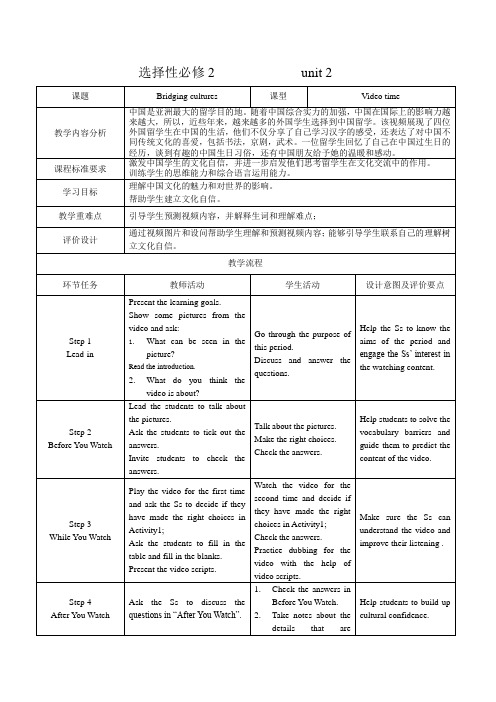
激发中国学生的文化自信,并进一步启发他们思考留学生在文化交流中的作用。
训练学生的思维能力和综合语言运用能力。
学习目标
理解中国文化的魅力和对世界的影响。
帮助学生建立文化自信。
教学重难点
引导学生预测视频内容,并解释生词和理解难点;
评价设计
通过视频图片和设问帮助学生理解和预测视频内容;能够引导学生联系自己的理解树立文化自信。
Make the right choices.
Check the answers.
Help students to solve the vocabulary barriers and guide them to predict the content of the video.
Step 3
While You Watch
教学流程
环节任务
教师活动
学生活动
设计意图及评价要点
Step 1
Lead-in
Present the learning goals.
Show some picturesfrom the videoand ask:
1.What can be seenin the picture?
Read the introduction.
2.Take notes about the details that aredisplayed in the painting.
Help students tobuild up cultural confidencesk the students totalk about a kind of Chinese culture to a foreigner.
Step 2
case study和across case study -回复
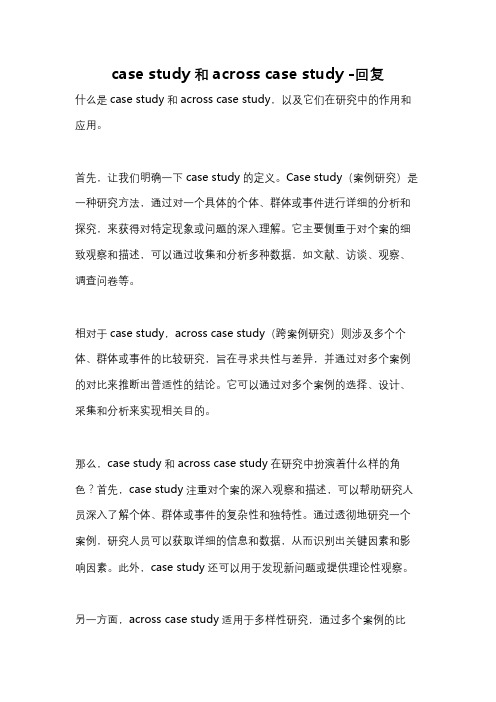
case study和across case study -回复什么是case study和across case study,以及它们在研究中的作用和应用。
首先,让我们明确一下case study的定义。
Case study(案例研究)是一种研究方法,通过对一个具体的个体、群体或事件进行详细的分析和探究,来获得对特定现象或问题的深入理解。
它主要侧重于对个案的细致观察和描述,可以通过收集和分析多种数据,如文献、访谈、观察、调查问卷等。
相对于case study,across case study(跨案例研究)则涉及多个个体、群体或事件的比较研究,旨在寻求共性与差异,并通过对多个案例的对比来推断出普适性的结论。
它可以通过对多个案例的选择、设计、采集和分析来实现相关目的。
那么,case study和across case study在研究中扮演着什么样的角色?首先,case study注重对个案的深入观察和描述,可以帮助研究人员深入了解个体、群体或事件的复杂性和独特性。
通过透彻地研究一个案例,研究人员可以获取详细的信息和数据,从而识别出关键因素和影响因素。
此外,case study还可以用于发现新问题或提供理论性观察。
另一方面,across case study适用于多样性研究,通过多个案例的比较,可以发现共性规律和差异,有助于构建或验证理论和模型。
它可以帮助研究人员从更广泛的视角来理解现象,并具有潜在的转化和应用的可能性。
通过对比多个案例,研究人员可以识别出普适性的结论或理论,并提供对更广泛群体或现象的解释和预测。
在实际应用中,case study和across case study都有各自的优点和局限性。
在进行case study时,研究人员可以深入了解特定案例的细节,并生成丰富的数据,从而获得深刻的洞察力。
然而,由于个案的独特性,case study的结论无法直接推广到整个群体或现象上。
相比之下,across case study可以帮助研究人员识别普遍规律和变量之间的关系。
卢峭眉听力词汇

雅思双向听力法真题词汇卢峭梅校园生活场景学术教育attendance 出勤exemption 免休re-sit 重考补考report 报告set exercise 固定的练习reference 参考书目bibliography 参考书目plagiarism 剽窃抄袭cheat 作弊high distinction 优异distinction 良好credit 合格pass 及格fail 不及格arts 文科science 理科core books 核心书目freshman 大学一年级学生sophomore 大学二年级学生junior 大学三年级学生senior 大学四年级学生auditorium 大礼堂recreation centre 娱乐中心loose spiral notebook 活页本curriculum vitae 履历tertiary education 高等教育preparatory year 预科drop out 辍学curriculum 课程draft 草稿enrollment 注册register/enroll 登记,报到student union office 学生会办公室opening ceremony开学典礼orientation meeting新生学校综合情况介绍会application form 申请表letter of recommendation 推荐信credit/point/credit point 学分credit system学分制mark/ score/ grade分数,成绩assessment 对学生的学习情况进行评估handout分发的印刷品assignment 作业presentation专题发言project课外课题paper/ thesis/ dissertation 毕业论文essay 短论文deadline 截止时期extension 延期journal每周要做的作业participation 课堂参与情况tutorial 个别辅导讨论课office hour (教授与学生)面谈的时间secondary education中等教育higher education高等教育adult education成人教育open admission免试入学制kindergarten/ day-care center幼儿园nursery school托儿所primary/elementary school小学secondary school中学junior high school初中senior high school高中attached middle school附中technical school技校polytechnic institute理工学院/ 科技大学key school重点中学graduate school研究生院open university夜大、函大independent/private school私立学校public school公立学校school of arts and sciences 文理学院auditor/guest student旁听生boarder住宿生undergraduate 本科postgraduate 研究生Bachelor 学士Master 硕士Doctor 博士alumnus/ alumna男/ 女校友alma mater母校graduation appraisal毕业评估graduation ceremony/ commencement毕业典礼diploma/ graduation certificate毕业证书degree学位associate diploma专科证书certificate 证书qualification 资格expert专家consultant顾问faculty 教职员工的总称teaching assistant 助教dean学校分院长,系主任principal/ president校长coordinator 课程协调人/ 班主任lecturer 讲师assistant professor 助理教授associate professor副教授professor 教授school counselor 校辅导员supervisor 论文指导老师career advisor 职业指导官adviser/ mentor 导师chancellor 名誉校长president大学校长coeducation男女生同校制度term/semester学期blue-book考卷academic year 学年final-examination期末考核quiz小测验oral test口试open-book exam开卷考pop test抽考placement test 入学分级考试aptitude test 学能测试teaching facilities教学设施sponsor 赞助人discipline 科目English proficiency 英语流利程度supplementary reading material 补充阅读材料prescribed textbook 指定课本methodology 教学法debate 辩论seminar 研讨会lecture 讲座conference hall 会议厅venue 场地grant 助学金loan 贷款stipend 固定奖学金tuition 学费scholarship 本科奖学金fellowship 研究生奖学金student union 学生会schedule/ school timetable课程表course arrangement 课程安排presentation 课上口头表达project 研究项目课题report 报告defense 答辩syllabus 教学大纲extracurricular 课外课程课程选择beginner course 入门课foundation course 基础课basic course 基础课elementary course 初级课primary course 初级课secondary course中级课intermediate course中级课advanced course高级课compulsory course 必修课required course 必修课optional course 选修课elective course 选修课specialized course 专业课general course 公共课major 主修minor 副修archaeology 考古学architecture 建筑学astronomy 天文学agriculture 农业geography 地理geology 地质chemistry 化学micro-biology 微生物学marine-biology 海洋生物学hospitality 酒店管理服务管理botany 植物学zoology 动物学ecology 生态学electronics 电子学mathematics/maths 数学statistics 统计学genetics 遗传学physiology 生理学literature文学philosophy哲学history历史art艺术sociology社会学linguistics语言学psychology心理学engineering工程学business商务law法学economics经济学finance金融学accounting会计学banking银行学biochemistry生物化学physics 物理学anthropology 人类学science 科学图书馆touch-screen information service 触摸屏extension 续借后的延长期renew(al)续借due 到期overdue 过期date of expiry 到期日catalogue under title/author 书名目录/著者目录fiction/non-fiction 小说类/非小说类reference book section 工具书阅览室encyclopedia 百科全书atlas 地图册almanac 年鉴magnetically coded 磁化的有条形码的demagnetize 消磁available 可借阅的in stock 有存货图书馆有stack 书库open shelf 开架书closed reserved 非外借图书处out on loan 借出去了reservation list 预约单prospectus 学校介绍学生手册leaflet 散页Forbes 福布斯index 索引front/back cover 封面/封底fly page/leaf 扉页retrieval 检索audio visual resource center 视听资料室reprint 再版archives 档案volume 卷bound volume 合订版abstract 摘要microform 缩微borrow 借用lend/ loan 借给newspaper 报纸journal 杂志periodical 期刊category 类别pay fines 付罚款check out 登记并借出return in time 及时归还interlibrary service图书馆间馆际服务information desk 服务台library card 借书证call slip索书单current/ back issues 即期/ 过期刊物librarian and reader 图书馆员和读者student card 学生证loan period 借书期circulation desk 借书台电脑机房internet café 网吧lab rules 计算机室规程printer 打印机copier 复印机fax machine 传真机Macintosh 苹果计算机hardware 硬件software 软件network 网络access to the net 访问网络floppy disk软盘hard disk硬盘CD-ROM 光盘驱动器monitor 监视器 keyboard 键盘mouse device 鼠标modem 调制解调器setup安装uninstall卸载operation system操作系统program程序word/data processing 文字/数据处理user用户click点击update更新data base数据库manual指南menu菜单password口令virus病毒web page网页website网站online在线email电子邮件firewall防火墙log on 登录virus 病毒laptop 笔记本电脑课题研究调查have it blank 可以不填空着feedback 反馈research 研究poll 民意调查survey 调查analyze data 分析数据questionnaire 调查问卷case study 案例调查observation 观察法hypothesis 假设statistics 统计valid/invalid 有效的/无效的data/ datum 数据investigation 调查quantitative定量的qualitative 定性的significant difference 显著差异interview 访谈respondent/ interviewee 被调查者multiple choice question 选择题results 结果conclusion 结论interpretation 解释/阐释opinion 观点具体授课fertile soil沃土hard hoofed animal 硬蹄动物cattle 牛livestock 牲畜evaporation 蒸发irrigation 灌溉solar power 太阳能nuclear power 核能alternative energy 可替代能源carbon dioxide 二氧化碳aluminum 铝population density 人口密度pollution 污染sewage 污水排除consumption 消耗greenhouse effect 温室效应El Nino 厄尔尼诺fossil 化石tribe 部落Aztec 阿斯台克族ageing population 人口老龄化meet the criteria 符合标准generation of electricity 发电reservoir 水库boom 繁荣sprawl 蔓延settlement 殖民地profile 外形pendulum 钟摆innovation 革新commercialization 商业化globalization 全球化utilize 利用moisture 潮湿season 风化timber 木料processing 处理environment 环境resource 资源recycling 再循环manilla folder 牛皮纸夹treaty 条约military 军事的milestone 里程碑internal clock 生物钟charity 慈善depression 抑郁fund raising 募捐endangered species 濒危物种rare species 稀有物种kangaroo 袋鼠koala 考拉lizard 蜥蜴emu 鸸鹋ostrich 鸵鸟penguin 企鹅dolphin 海豚whale 鲸falcon 猎鹰shark 鲨鱼bat 蝙蝠kiwi 几维鸟mammal 哺乳动物reptile 爬行动物toad 蟾蜍dinosaur 恐龙crocodile 鳄鱼goat 山羊horse马hen 母鸡rare lion 稀有狮子elephant 大象parrot 鹦鹉snake 蛇tiger 虎marsupial 有袋动物pouch 袋状物migrant bird 候鸟squirrel 松鼠校外生活房屋住宿pets not allowed 不许养宠物take property insurance 买财产保险blackout 停电emergency/fire gate 紧急出口lift/elevator 升降梯attic 阁楼twin room 双人间stereo system 音响water heater 热水器vacuum cleaner 吸尘器coffee maker 咖啡机refrigerator/fridge 冰箱bed linen 床上用品real estate agency 房屋中介property agency 房屋中介land lord/lady 房东on lease/for rent 出租deposit 订金、押金utilities 水电煤气等公共设施费incoming phone is free 打进电话免费noisy 吵闹的humid 潮湿的laundry room 洗衣房burglar 入室抢劫者electric cooker 电灶gas cooker 煤气灶cooker hood 抽油烟机cassette recorder 录音机fire place 壁炉electric heater 电暖气surroundings 环境rural areas 农村suburb 郊区downtown 市区semi-detached house 半独立式住宅detached house 独立式住宅terraced houses 排房flat/ apartment 公寓dormitory/ dorm 宿舍student hotel 学生旅馆youth hostel 青年招待所furnished 有家具的房子unfurnished 无家具的房子entrance hall (lobby, porch) 门厅balcony 阳台bed-sit 卧室兼起居室bedroom卧室living room/ lounge 起居室single room 单人间double bedroom/twin room 双人间(双人床/两张床)bathroom 浴室shower 淋浴kitchen 厨房shared kitchen 共用厨房garage 车库carpet 地毯rug 小地毯pillow case 枕套sheet 被单mattress 床垫spread床罩pillow 枕头cushion 软垫blanket 毯子towel 毛巾coffee table 茶几armchair 单人沙发sofa 沙发kettle 水壶stool 厨房高脚椅tap 水龙头sink 洗碗池cupboard 橱柜bath 浴缸toilet 马桶stove 炉子oven 烤箱dishwasher 洗碗机freezer 冷冻冰箱telephone 电话washing machine 洗衣机air-conditioner 空调central air-conditioning中央空调central heating 中央暖气系统electric fans 电扇microwave oven 微波炉electric stoves电炉radiator暖气rent/rental 房租rental price 租价no privacy 无隐私partially furnished 配备部分家具的residential number 住宅号码available 可入住的mobile phone 手机cellular phone 手机cordless phone 无绳电话satellite TV卫星电视cable TV 有线电视antenna 天线aerial 天线closed circuit TV 闭路电视lobby 大堂lift lobby 电梯间cellar酒窖client 客户tenant 房客home stay 住在当地人家host family 住在当地人家shared accommodation 合租university hall 学校宿舍hall of residence 学校宿舍accommodation 住宿maximum rent 最高房租minimum rent 最底房租suite 套房decorate 装饰ornament 美化shutter/blinder 百叶窗curtain 窗帘utensil 器皿旅游度假scuba-diving 深水潜水snorkeling 潜水glass-bottom boat 玻璃底船coral 珊瑚water skiing 划水white water rafting 漂流sunrise 日出sunset 日落jellyfish 水母/海蛰sun block/sun screen 防晒霜sun burnt 太阳晒伤tan 日晒后的颜色bathers 泳衣trunks 泳裤sunglasses 太阳镜beach towel 沙滩浴巾tent 帐篷picnic 野餐expedition 远征考察excursion 短程旅行get lost 迷路compass 指南针helmet 头盔torch/flash light 手电筒mosquito net 蚊帐insect 昆虫stinger 小咬repellent 驱虫剂hiking boots 登山靴socks 短袜irritation plants 刺激性的植物bungee jumping 蹦极rock climbing 攀岩hang gliding 滑翔parachuting 跳伞castle 城堡ancient temple 古庙cathedral 大教堂aquarium 水族馆botanical garden 植物园amusement park 游乐场organic farm 有机农场valley 峡谷waterfall 瀑布hot spring 温泉bush walking 灌木丛走resort 旅游胜地voyage 航行package tour 全包游coach 旅游轿车长途汽车off-road driving 越野four-wheel drive 四驱车caravan 房车express train 快车economy class 经济仓cottage 小别墅inn 客栈B&B 提供床铺和早餐的旅店cabin 小木屋itinerary 旅游行程great barrier reef 大堡礁Sydney Opera House 悉尼歌剧院Uluru(Ayers Rock)红岩山Stonehenge 巨石镇go camping 宿营wild-life zoo 野生动物园safari park 能开车进去游览的野生动物园beach 海滩coast 海岸national park 国家公园charter flight包机domestic animal 家畜sleeping bag 睡袋recreation office 娱乐办公室brochure 旅游介绍的小册子mountain bike 山地车pannier 筐backpack 双肩背包directory 目录snorer 大酣者reservation 预约schedule 时间表fare 票款vacant seat 空座extra charge 额外收费heritage 遗产commence the tour 开始旅行handicapped 残疾人wheel chair 轮椅exhibition 展览reproduction 复制品sculpture 雕塑diving gear 潜水设备rain forest 雨林leisure activity 休闲活动profile 轮廓vineyard 葡萄园lodge 旅馆visa extension 签证延期non-open time 非对外开放时间travel agency 旅行社flight number 航班号book the ticket 订票credit card 信用卡passport 护照driving license 驾照expire (驾照、护照等)过期check in 办理登机手续take off 起飞land 降落motel 汽车旅馆hostel 青年旅社museum 博物馆souvenir 纪念品art gallery 美术馆hiking 徒步旅行hitch-hike 搭便车旅行surfing 冲浪skiing 滑雪bag-packer 背包自助旅行的人platform 站台健康营养calories 卡路里calcium 钙sodium 钠fat 脂肪vitamin 维生素protein 蛋白质dietary fiber 食用性纤维nutrient 营养物质cereal 谷物amino acid 氨基酸metabolism 新陈代谢indigestion 消化不良tissue 组织healthy diet pyramid 健康饮食金字塔tennis 网球table tennis乒乓球polo 马球water polo 水球skiing 滑雪water skiing 划水gym 健身房体育馆yoga 瑜珈cycling 骑自行车jogging 慢跑weight training 力量性训练aerobics 有氧操stadium 体育场hi-tich fitness center 高科技健身中心squash 壁球cricket板球rugby 橄榄球golf 高尔夫球bowling 保龄billiard house 台球厅pool 落袋snooker 斯诺克hockey 曲棍球ice hockey 冰球skating 滑冰roller blade 单排轮滑badminton 羽毛球baseball 棒球softball 垒球beach volleyball 沙滩排球football 足球treadmill 跑步机track and field 田径tournament 联赛athlete 运动员referee 裁判coach 教练cheer leader 拉拉队长martial art 武术wrestling 摔交judo 柔道karate 空手道box 拳击canoeing 独木舟lung infection 肺部感染drowsiness 嗜睡的yellow fever 黄热病vaccine injection 疫苗注射chemist's 药店pharmacy 药店drug store 药店optic examination 视力检查allergy 过敏leprosy 麻风病epidemic 流行病chronic 慢性病precaution 预防flu/influenza 流感ulcer溃疡clinic 诊所hospital 医院first aid kit 急救箱first aid station 急救站patient 病人dentist 牙医dizzy 晕headache 头疼cough 咳嗽pulse 脉搏blood pressure 血压symptom 症状sore throat 嗓子疼stuffed nose 鼻子堵running nose 流鼻涕surgeon 外科医生prescription 处方penicillin 青霉素aspirin 阿司匹林antibiotics 抗生素ward 病房life expectancy 估计寿命hay fever 花粉热pill 药丸tablet 药片herb 草药capsule 胶囊ointment 药膏lozenge 含片syrup 糖浆drop 滴剂food poison 食物中毒remedy 治疗法check up 体检insomnia 失眠arthritis 关节炎fatigue 疲劳twist 扭伤sprain 扭伤swell 肿胀bruise 瘀伤sneeze打喷嚏hiccup 打嗝diarrhoea 拉肚子therapy 治疗diagnosis 诊断dosage 剂量配药学生银行cash 现金currency 流通货币bill/note 纸币coin 硬币cheque 支票chequebook 支票本traveller's cheque 旅行支票credit card 信用卡Master Card万事达卡Visa Card维萨卡American Express Card美国运通卡account 帐户PIN 银行密码activate 击活deposit 存withdraw取bank statement 银行对帐单interest rate 利率ATM 自动取款机overdraft 透支mortgage 抵押贷款net 净利gross 总额bonus 奖金interest 利息branch 分支eligible 合格的individual circumstances 个人情况documentation 文件special concession 特殊优惠money order 汇票loan 贷款transfer 转帐用餐饮食common room 师生公用的休息室canteen 食堂dining hall 餐厅refectory 食堂buffet 自助餐barbecue 烧烤snack bar 零食店candy bar 糖果店vending machine 自动售货机spicy/hot 辣chilli 辣椒sweet 甜sour 酸bitter 苦salty 咸no cheese product 非奶酪制品no red meat 不吃红肉garden salad 蔬菜沙拉fish & chips 炸鱼派和土豆条snack 零食refreshment 零食pork 猪肉steak 牛排sandwich 三明治appetizer 开胃菜main course 主菜dessert 甜点beverage 饮料vegetarian 素食的sea food 海鲜take-away 外卖drive-in 免下车路边餐馆pub 酒馆客栈instant coffee 速溶咖啡espresso蒸馏咖啡cappuccino 热牛奶咖啡brewed coffee 煮好的咖啡mineral water 矿泉水wine 葡萄酒black tea 红茶skimmed milk 脱脂牛奶yogurt 酸奶curry 咖喱ginger姜ketchup 调味番茄酱vinegar 醋toast吐司soup 汤dough 生面团aubergine 茄子egg plant 茄子broccoli 西兰花cauliflower 菜花celery 芹菜rape 油菜spinach 菠菜cucumber 黄瓜mushroom 蘑菇pumpkin 南瓜lettuce 生菜asparagus 芦笋lentil 扁豆pea 豌豆文艺演出circus 马戏acrobat/acrobatic 杂技演员/杂技magic/trick 魔术juggle 手技ballet 芭蕾mime 哑剧comedy 喜剧seven-screen cinema 能反映七部电影的电影院guitar 吉他comedian 喜剧演员puppet 木偶trapeze 秋千release 发行blockbuster 大片folk song 民歌classic music 古典音乐documentary 记录片thriller 惊竦片人物描述over-weight 胖sturdy 壮stout 结实的stocky 结实的solid 壮实的chubby 圆胖的plump丰满的medium-built 中等身材的slender 苗条的lean 瘦blonde 金发的fair 黄发的curly 卷发的straight 直发的beard 下巴上的胡子moustache 嘴巴上的胡子clean-shaven胡子刮得很干净bald 谢顶的wig假发dye 染发spectacles 眼镜contact lenses 隐型眼镜hat 礼帽cap 棒球帽umbrella 伞cane/stick 拐杖dimple 酒窝pimple 青春痘freckle 雀斑wrinkle 皱纹chin 下巴cheek 面颊forehead 前额blouse 女士衬衫beauty spot 美人痣scar疤痕short hair短发long hair长发tall/ high高short矮thin瘦的average height 平均高度wear/ be in tie 戴领带bow tie 领结T-shirt T 恤衫pullover 套头毛衣sweater 套头衫/ 运动衫suit西服/ 套装jumper 套头外衣trousers 裤子jeans 牛仔裤sandal 凉鞋jewelry珠宝laughter line 笑纹thick eyebrows 浓眉long eyelashes 长睫毛high lined forehead 大脑门small chin 小下巴high cheek bones 高颧骨full lips 后嘴唇turn-up nose 翘鼻double chin 双下巴crew cut 平头short spiky hair 寸头formal clothes 正装casual clothes 休闲服polo shirt 马球衫loose clothes 宽松服装tight clothes 紧身服装pony tail 马尾辫plait 编辫pig tail 小编辫wear。
新时代研究生学术英语综合教程2第四单元

新时代研究生学术英语综合教程2第四单元The field of academic English for graduate students has become increasingly important in the new era as the globalization of higher education and research has led to a greater need for effective communication and collaboration across linguistic and cultural boundaries. The fourth unit of the "New Era Graduate Academic English Integrated Course 2" aims to equip students with the necessary skills and strategies to navigate the complex landscape of academic writing and presentation in English.One of the key focuses of this unit is the development of critical thinking and analytical skills. Graduate students are expected to engage in in-depth research and analysis, and the ability to think critically and formulate well-reasoned arguments is essential for success in academic endeavors. The course materials in this unit provide students with a solid foundation in critical reading and writing, teaching them how to identify and evaluate the underlying assumptions and biases in academic texts, as well as how to construct their own persuasive and well-supported arguments.Another important aspect of this unit is the emphasis on academic writing conventions and styles. Graduate-level writing in the English language requires a high level of proficiency in areas such as grammar, syntax, and vocabulary, as well as a strong understanding of the specific rhetorical structures and formatting requirements of academic genres such as research papers, literature reviews, and dissertations. The course materials in this unit cover a range of writing strategies and techniques, including effective organization, coherence, and cohesion, as well as the appropriate use of citations and references.In addition to written communication, this unit also addresses the skills required for effective oral presentations in academic settings. Graduate students are often called upon to present their research findings and ideas to their peers and faculty members, and the ability to deliver clear, concise, and engaging presentations is crucial for success in these situations. The course materials in this unit provide students with guidance on topics such as presentation structure, visual aids, and delivery techniques, as well as strategies for handling questions and engaging with the audience.One of the unique features of this unit is its focus on the cultural and linguistic diversity of the graduate student population. Many graduate programs, particularly in the sciences and engineering fields, attract students from a wide range of cultural and linguisticbackgrounds, and navigating the academic landscape in a non-native language can present significant challenges. The course materials in this unit address these challenges by providing students with insights into the cultural norms and expectations of the English-speaking academic community, as well as strategies for overcoming language barriers and effectively communicating their ideas to an international audience.Throughout the unit, students are encouraged to engage in hands-on, collaborative learning activities that allow them to apply the concepts and strategies they have learned to real-world academic scenarios. This includes peer review exercises, group discussions, and simulated presentation scenarios, all of which are designed to help students develop the practical skills and confidence they need to succeed in their academic pursuits.Overall, the fourth unit of the "New Era Graduate Academic English Integrated Course 2" represents a comprehensive and multifaceted approach to preparing graduate students for the challenges and demands of academic communication in English. By fostering critical thinking, analytical skills, and proficiency in written and oral communication, this unit equips students with the tools they need to thrive in the increasingly globalized and competitive world of graduate-level research and scholarship.。
非母语英语教师的定位与自我调适解析
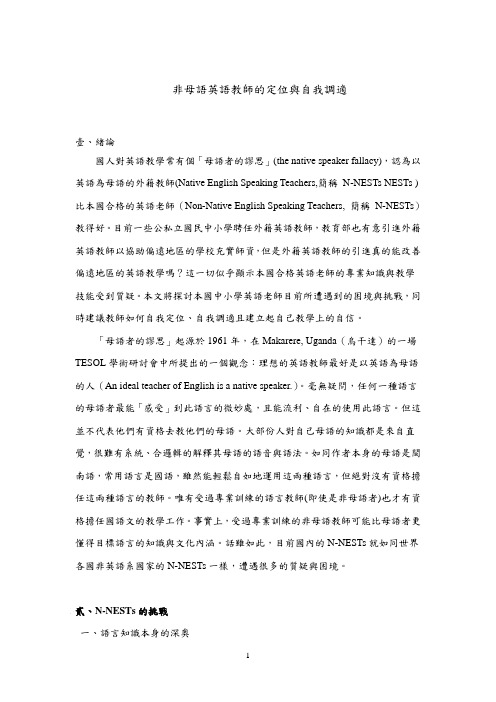
非母語英語教師的定位與自我調適壹、緒論國人對英語教學常有個「母語者的謬思」(the native speaker fallacy),認為以英語為母語的外籍教師(Native English Speaking Teachers,簡稱N-NESTs NESTs )比本國合格的英語老師(Non-Native English Speaking Teachers, 簡稱N-NESTs)教得好。
目前一些公私立國民中小學聘任外籍英語教師,教育部也有意引進外籍英語教師以協助偏遠地區的學校充實師資,但是外籍英語教師的引進真的能改善偏遠地區的英語教學嗎?這一切似乎顯示本國合格英語老師的專業知識與教學技能受到質疑。
本文將探討本國中小學英語老師目前所遭遇到的困境與挑戰,同時建議教師如何自我定位、自我調適且建立起自己教學上的自信。
「母語者的謬思」起源於1961年,在Makarere, Uganda(烏干達)的一場TESOL學術研討會中所提出的一個觀念:理想的英語教師最好是以英語為母語的人(An ideal teacher of English is a native speaker.)。
毫無疑問,任何一種語言的母語者最能「感受」到此語言的微妙處,且能流利、自在的使用此語言。
但這並不代表他們有資格去教他們的母語。
大部份人對自己母語的知識都是來自直覺,很難有系統、合邏輯的解釋其母語的語音與語法。
如同作者本身的母語是閩南語,常用語言是國語,雖然能輕鬆自如地運用這兩種語言,但絕對沒有資格擔任這兩種語言的教師。
唯有受過專業訓練的語言教師(即使是非母語者)也才有資格擔任國語文的教學工作。
事實上,受過專業訓練的非母語教師可能比母語者更懂得目標語言的知識與文化內涵。
話雖如此,目前國內的N-NESTs尌如同世界各國非英語系國家的N-NESTs一樣,遭遇很多的質疑與困境。
貳、N-NESTs的挑戰一、語言知識本身的深奧根據Phillipson(1996)針對198位的「教英語為外語的教師」進行調查,請他們將自認最困難的英語文能力加以排序。
dryj 教案
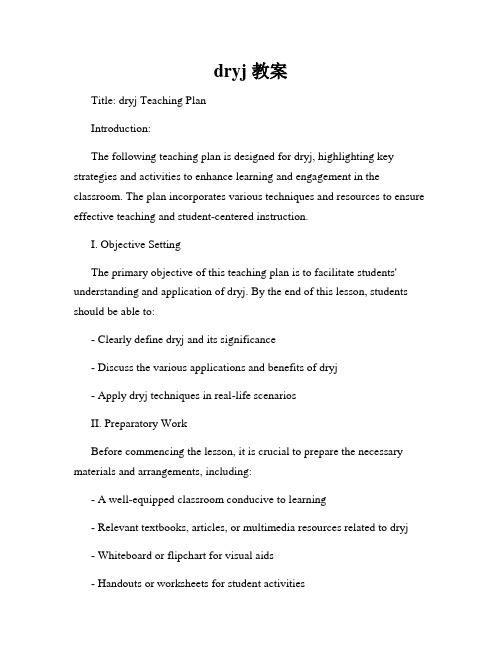
dryj 教案Title: dryj Teaching PlanIntroduction:The following teaching plan is designed for dryj, highlighting key strategies and activities to enhance learning and engagement in the classroom. The plan incorporates various techniques and resources to ensure effective teaching and student-centered instruction.I. Objective SettingThe primary objective of this teaching plan is to facilitate students' understanding and application of dryj. By the end of this lesson, students should be able to:- Clearly define dryj and its significance- Discuss the various applications and benefits of dryj- Apply dryj techniques in real-life scenariosII. Preparatory WorkBefore commencing the lesson, it is crucial to prepare the necessary materials and arrangements, including:- A well-equipped classroom conducive to learning- Relevant textbooks, articles, or multimedia resources related to dryj- Whiteboard or flipchart for visual aids- Handouts or worksheets for student activities- Internet access (if needed) for additional researchIII. Teaching Strategies1. Engage: To capture students' attention and activate their prior knowledge, begin the lesson with a thought-provoking question or a stimulating activity related to dryj. This will stimulate curiosity and generate interest among the students.2. Introduce: Present a clear and concise introduction to dryj, highlighting its definition, purpose, and relevance. Use relatable examples or anecdotes that will enable students to connect and understand the concept easily.3. Demonstrate: Employ various visuals, multimedia presentations, or real-life examples to demonstrate the application and benefits of dryj. Interactive demonstrations can help students grasp the concept more effectively.4. Collaborative Learning: Encourage students to work in pairs or small groups to discuss and share their understanding of dryj. This fosters communication, teamwork, and critical thinking skills. Assign specific tasks, such as case studies or problem-solving activities, to promote active participation.5. Practice: Provide opportunities for students to practice dryj techniques through hands-on activities, exercises, or simulations. This practical application will enhance their comprehension and build confidence in utilizing dryj in real-world situations.6. Evaluate: Continuously assess students' understanding and progress through class discussions, quizzes, or short assessments. Individual feedback should be provided to identify areas of improvement and reinforce learning.IV. Differentiation and AdaptationsTo meet the diverse learning needs of students, consider the following strategies:- Provide additional resources or readings for advanced learners to delve deeper into the subject matter.- Offer extra support, guidance, or simplified explanations for students who require additional assistance.- Incorporate visual aids, manipulatives, or multimedia resources to cater to different learning styles.- Offer extension activities or challenges to encourage higher-level thinking for students who grasp the material quickly.V. Recap and ConclusionConclude the lesson by summarizing the key points covered in the teaching plan. Allow time for students to ask questions or seek clarification on any content they find challenging. Emphasize the importance of regular practice and continuous application of dryj techniques for mastery.VI. Follow-up ActivitiesTo reinforce learning and promote long-term retention, suggest follow-up activities outside the classroom, such as:- Assigning relevant readings or research assignments related to dryj- Organizing group discussions or presentations based on real-life examples of dryj- Encouraging students to apply dryj techniques in their daily lives and reflect on the outcomesConclusion:This teaching plan provides a comprehensive framework for effectively teaching dryj. By implementing these strategies and adapting them to individual student needs, educators can create a stimulating and engaging learning environment that fosters understanding, application, and retention of dryj knowledge.。
高三物理选修3-1知识点复习6

1.(多选)下列关于电功、电功率和焦耳定律的说法中正确
的是( )
A.电功率越大,电流做功越快,电路中产生的焦耳热一定
越多
B.W=UIt适用于任何电路,而W=
U2 R
t只适用于纯电阻电
路
C.在非纯电阻电路中,UI>I2R
D.焦耳热Q=I2Rt适用于任何电路
【解析】 解答本题的关键是正确区分电功和电功率.由电
综合解题方略——能量守恒在电路中的应用 某一直流电动机提升重物的装置如图2-5-2所 示,重物的质量m=50 kg,电源提供的电压U=110 V,不计一 切摩擦.当电动机以v=0.9 m/s的恒定速度向上提升重物时,电 路中的电流I=5.0 A,求:
图2-5-2
(1)由此可知电动机线圈的电阻R是多少? (2)用此电动机提升质量为m′=20 kg的重物,电动机的输 入功率不变,提升速度是多少?(g取10 m/s2)
●新课导入建议 如图教2-5-1所示,把一根大头针插在一小块硬纸片上, 用浆糊把纸贴在台灯的灯泡上,使大头针的针尖朝上.然后用3 张纸条做一小风车,把风车放在针尖上.打开台灯,过一会发 现,风车转动起来,你知道这是为什么吗?学过了本节的知识, 你就能解决这个问题.
图教 2-5-1
●教学流程设计
课前预习安排:
1.串联电路
各部分电路电流I相同,根据P=I2R, 各电阻上的电功率与电阻成正比 功率关系总功率P总=UI=U1+U2+…+UnI= P1+P2+…+Pn 2.并联电路
各支路电压相同,根据P=UR2,各支路电阻 功率关系上的电功率与电阻成反比
总 P1+功P率2+P总…=+UIP=n UI1+I2+…+In=
课
堂
教法分析
互
高考英语复习(新人教版)教材知识解读 选择性必修二 Unit 2 Bridging Cultures
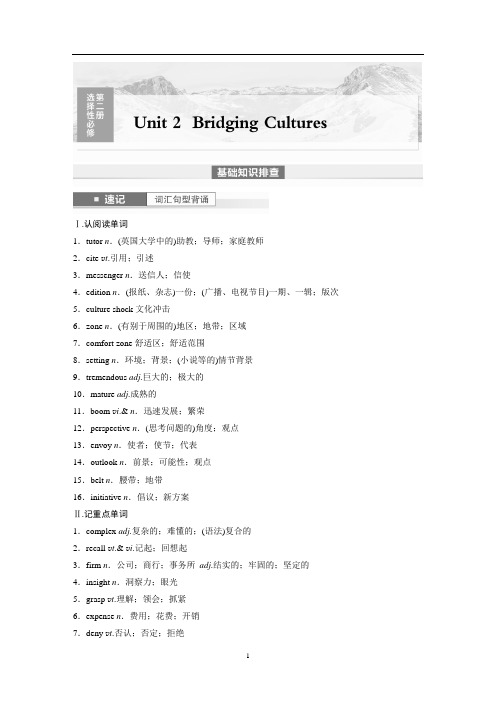
Ⅰ.认阅读单词1.tutor n.(英国大学中的)助教;导师;家庭教师2.cite v t.引用;引述3.messenger n.送信人;信使4.edition n.(报纸、杂志)一份;(广播、电视节目)一期、一辑;版次5.culture shock文化冲击6.zone n.(有别于周围的)地区;地带;区域7.comfort zone舒适区;舒适范围8.setting n.环境;背景;(小说等的)情节背景9.tremendous adj.巨大的;极大的10.mature adj.成熟的11.boom v i.& n.迅速发展;繁荣12.perspective n.(思考问题的)角度;观点13.envoy n.使者;使节;代表14.outlook n.前景;可能性;观点15.belt n.腰带;地带16.initiative n.倡议;新方案Ⅱ.记重点单词1.complex adj.复杂的;难懂的;(语法)复合的2.recall v t.& v i.记起;回想起3.firm n.公司;商行;事务所adj.结实的;牢固的;坚定的4.insight n.洞察力;眼光5.grasp v t.理解;领会;抓紧6.expense n.费用;花费;开销7.deny v t.否认;否定;拒绝8.gain v t.获得;赢得;取得;增加n.好处;增加9.angle n.角;角度;立场10.sincerely ad v.真诚地;诚实地11.budget n.预算12.outcome n.结果;效果Ⅲ.知拓展单词1.qualification n.(通过考试或学习课程取得的)资格;学历→qualify v t.& v i.(使)具备资格;(使)合格→qualified adj.有资格的;称职的2.ambition n.追求的目标;夙愿;野心;抱负→ambitious adj.有野心的;有雄心的3.adaptation n.适应;改编本→adapt v t.(使)适应;改编4.comfort n.安慰;令人感到安慰的人或事物;舒服;安逸v t.安慰;抚慰→comfortable adj.令人舒适的;舒服的→uncomfortable adj.不舒服的5.participate v i.参加;参与→participation n.参加;参与→participant n.参与者6.presentation n.报告;陈述;出示;拿出→present v t.颁发;赠送;呈递n.礼物adj.现在的;出席的7.engage v i.参加;参与(活动) v t.吸引(注意力、兴趣);雇用→engaged adj.忙于;从事于;已订婚的→engagement n.订婚;约定8.involve v t.包含;需要;涉及;影响;(使)参加→involved adj.参与的;投入的→involvement n.参与9.overwhelming adj.无法抗拒的;巨大的;压倒性的→overwhelm v t.(常用于被动语态)使不知所措;压倒10.homesickness n.思乡病;乡愁→homesick adj.想家的;思乡的11.motivated adj.积极的;主动的→motivation n.动力;积极性;动机→motivate v t.成为……的动机;激发;激励12.advisor n.(also -ser)顾问→advise v t.& v i.建议;劝告→advice n.建议;忠告13.reasonable adj.有道理的;合情理的→reasonably ad v.有理地;合理地→reason n.原因;道理v t.& v i.推理,推断→unreasonable adj.不合理的;不公正的14.expectation n.期望;预期;期待→expect v t.预料;期望15.applicant n.申请人→apply v i.申请v t.应用;适用;涂;敷→application n.申请;申请书→app n.应用程序16.exposure n.接触;体验;暴露;揭露→expose v t.使接触;使体验;显露;使暴露于(险境)17.departure n.离开;启程;出发→depart v i.& v t.离开;启程;出发18.dramatic adj.巨大的;突然的;急剧的;戏剧(般)的→dramatically ad v.突然地;戏剧地;引人注目地→drama n.戏剧;戏剧性事件19.behave v t.表现v i.& v t.表现得体;有礼貌→behaviour/behavior n.行为;举止20.surroundings n.[pl.]环境;周围的事物→surrounding adj.周围的;附近的→surround v t.包围;围绕21.depressed adj.沮丧的;意志消沉的→depress v t.使沮丧;使忧愁→depression n.沮丧;抑郁22.strengthen v i.& v t.加强;增强;巩固→strong adj.强壮的→strength n.体力;优点23.optimistic adj.乐观的→optimism n.乐观主义24.competence n.能力;胜任;本领→competent adj.有能力的;称职的25.cooperate v i.合作;协作;配合→cooperation n.合作;协作26.logical adj.合乎逻辑的;合情合理的→logically ad v.逻辑上地→logic n.逻辑(学);道理1.independence n.独立independent adj.独立的;有主见的2.indicate v t.指示;表明3.industry n.产业4.influence n.& v t.影响5.informal adj.非正式的6.innocent adj.清白的;无辜的7.insert v t.插入8.inspect v t.检查;检验;审视Ⅳ.背核心短语1.participate in参加;参与2.speak up大声点说;明确表态3.feel at home舒服自在;不拘束4.engage in(使)从事;参与5.get involved in参与;卷入;与……有关联6.cost an arm and a leg(使)花一大笔钱7.side with支持;站在……的一边8.as far as I know据我所知9.as far as I am concerned就我而言;依我看来10.in summary总的来说;总之11.generally speaking一般来说Ⅴ.悟经典句式1.It was the first time that she had left China.(It was the first time that+过去完成时)这是她第一次离开中国。
- 1、下载文档前请自行甄别文档内容的完整性,平台不提供额外的编辑、内容补充、找答案等附加服务。
- 2、"仅部分预览"的文档,不可在线预览部分如存在完整性等问题,可反馈申请退款(可完整预览的文档不适用该条件!)。
- 3、如文档侵犯您的权益,请联系客服反馈,我们会尽快为您处理(人工客服工作时间:9:00-18:30)。
Integrative Case StudySmart Tech Case Study – 25%Smart Tech Mfg., a Canadian company is changing suppliers because the current supplier has proven to be unreliable. The company plans to maintain 20 days of inventory. This equates to 9,000 cases. (20 days = 1 month based on a working week of 5 days and a working month of 4 weeks). This inventory consists of preci-sion parts necessary to assemble its final products in their plant in Toronto and they are very fragile. The parts are under quota restrictions because the Canadian government is trying to encourage local development of this “high tech” product. It is in a very competitive marketplace in which innovation and responsiveness to cus-tomer demand is paramount.Smart Tech has narrowed its choice to two foreign suppliers. One supplier, HK Manufacturing is based in Beijing, China. The other, Fiesta Manufacturing is based in Mexico City, Mexico. High Tech plans to pur-chase 9,000 cases of parts at a time to ensure it meets demand for the final product.∙The MFN duty rate is 10% ad valorem.Price Quotes from the Suppliers∙ Fiesta Manufacturing = $5.00 per case, Ex Works∙(The Mexican supplier insists on Ex-Works terms of delivery and an inflexible order quantity).∙HK Manufacturing = $5.00 per case FOB (the Chinese supplier is very open to changing order quantities)Shipping Characteristics∙1500 cases fit in a 40-foot container if they are not palletized.∙1000 fit if they are palletized (20 pallets).∙1500 fit in a 53-foot tractor-trailer loaded on 25 pallets (the Mexican supplier will not ship un-palletized goods). It also insists that pallets be r eturned at the buyer’s expense.∙250 empty pallets can be loaded into a 53-foot trailer.Transit Times - China∙Local Delivery from Chinese supplier to Distribution Terminal = 1 day∙Inland to Port of Shanghai = 1 day∙Overseas from Shanghai to Vancouver = 14 days∙Inland Vancouver to Toronto Terminal = 3 days∙Toronto Terminal to Smart Tech = 1 dayTransit Times -Mexico∙By truck from Fiesta Manufacturing to High Tech = 5 days (but there are often delays of up to 2 days at the Mexican border adding an additional 2 days to the transit time).Transportation Costs - Full Container from China∙Local Delivery to Distribution Terminal in Beijing = $50.00 per container∙Inland transportation to Port of Shanghai = $ 150.00 per container∙Handling and loading charges at the port = $250.00 per container∙Shanghai to Vancouver = $ 3000.00 per container via Conference Line or$ 2700.00 via Non Conference Line (The Non ConferenceCarrier flies a Panamanian flag but is actually Canadian.)∙Port unloading fees = $250.00 per container∙Inland Vancouver to Toronto Terminal = $1,500.00 per container∙Local Delivery = $100.00 per container∙The cost of insurance in either case is 2% of the cost of goods and freight (transportation costs).∙Actual weight applies to the shipments.Transportation Costs from Mexico∙Mexico to Toronto = $ 3000.00 – in a 53 foot trailer∙Toronto to Mexico = $ 2500.00 - in a 53 foot trailerAssignmentCompare the options available to you. Prepare a report and recommend a buying option for High Tech Manu-facturingThe report must contain a:1. A case cost comparison of your options2. A total cost comparison of your options3. A reasoned explanation of all those factors that influenced your decision4. A reasoned explanation of those factors you have discountedPrepare a ReportThe report must contain:1.Diagrams of the 2 Supply Chain options2.An Executive Abstract3. A Cover Page4. A Table of Contents5. A GANNT chart detailing the contribution of group members6. A Report including introductory, main body and concluding sectionsGeneral Format∙Consider that you may want to submit a copy of your report to the firm, and hence you should use profes-sional standards in preparing your report∙Each group must present its proposal to the classFormal Report∙Work in groups of 6 or less∙The report must be typed and double-spaced.∙It should be between 1500 and 2500 words.∙Use subheadings within the report and when necessary.∙Plan the report carefully so as to develop an organized and non-redundant report. It should be organized and assembled as a continuous report and should not be several independent segments bound together.Due Date: December 02. 2010∙Reports submitted after this date may be marked (with penalty) but not returned because of the due dates re-quired for submitting final marks.∙Late reports will be penalized 10% per week.∙Report has a value of 25% of final mark.– 2 –。
